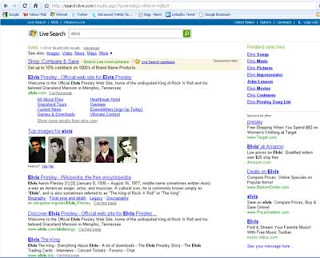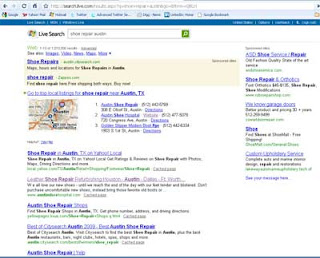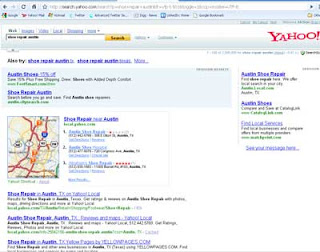Search Engine Results Pages (SERPS) have changed. No longer are there a few sponsored links on top, some to the side, then a list of "generic" or "natural" searches in a list taking up the main part of the page. Now there are links to images and videos with thumbnails to attract the eye along with "Shopping Results" and the "10-Pack" or "8-Pack" filling up the SERPS. If the searcher specifies a location in their search a number of links with a map image will also appear in the SERPS. All of those newer items sometimes crowd out the natural search results, which could bump your site down to the bottom of the first page or even to the second.
Because the human eye tends to focus on images first, SERPS with images will totally bust the traditional "Golden Triangle" or "Z" pattern of viewing as discovered in eye-tracking studies of the past. I'm going to use the example of searching for "Elvis" on Google, Live Search and Yahoo! to show how the images and video thumbnails look on SERPS which feature them. Click on the images below to see the actual web pages. Is your eye attracked to the images first? Mine were.

Here are some examples of SERPS where a location is included in the query. You can see how the map and "local" results change the SERPS:
Traditional web page only search optimization isn't going to cut it any more. If you have digital assets (in this case referring to images, videos and PDF files) they need to be optimized just like everything else on your web site. Here are some tips:
- Inventory your digital assets so you know what you're working with.
- Name digital files with a user-friendly, descriptive file name. "Chef Presentation of Banana Guacamole.jpg" is better than "img0900030233489a.jpg".
- Optimize PDFs using the pieces in the "Description" tab in the properties box. I created a guide posted on our Intranet to help those in my company who create PDFs.
- Create a video site map file for Google (http://www.google.com/support/webmasters/bin/answer.py?answer=80472&ctx=sibling).
Something to seriously consider is uploading your images to sites like Flickr and your videos to sites like YouTube. Even if you get your digital media files are indexed in Google, Yahoo! or Live image and video searches, you greatly increase your chances of people sharing and linking those files if they are on a site which specializes in such. Make sure to tag and describe the files thoroughly as well as make any copyright and trademark notices visible.
Videos need to have a call to action. It's good to set the profile the videos are uploaded to with a "Visit my website at www.mywebsite.com" message, but it's equally important to put that call to action somewhere in the video. This is because people can embed the videos into their own blogs or web pages, and they may not link to your site from their page. I think it's be a good idea to put the call to action at the beginning and the end of the video and at the bottom of each image.
The bottom line we must keep in mind is "Content is King." Content must be well-done, compelling and relevant to what your customers are searching for. All of the optimization is all for naught if you don't have good content.





I've been doing a lot of what you described to help screen readers and file management, now it serves another purpose. Cool! Nice to find out sometimes that you are doing something right.
ReplyDeleteThanks for leaving your comment. You bring up a good point.
ReplyDeleteA lot of web design principles fit together. Usability goes hand in hand with SEO just like having good content does.